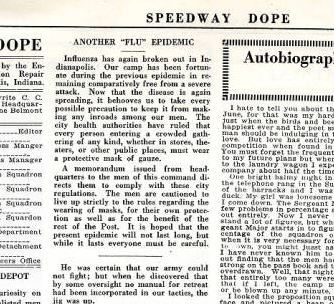 by Norma Erickson
by Norma Erickson
On the weekend of March 5-7, when the Indianapolis Motor Speedway hosts a mass COVID-19 vaccination event, it will not be the first time the track has had a brush with a pandemic. Although no races ran in 1917 and 1918 because of World War I, it was still a very active place during a very dangerous time.
The Speedway founders, recognized chiefly as promoters of the automobile in the early 20th century, were by no means stuck to the ground. The airplane was also a fascinating invention to them--so much so that they hosted an Aviation Week in June of 1910, with pursuit races and attempts at altitude records. This fit perfectly with Speedway principal Carl Fisher’s conviction that competition was the best way to prove a technology’s value. Newspapers quoted the Wright Brothers as claiming this was the “most important event of its kind ever attempted.”
Fisher’s esteem for aviation led to him writing an article in 1915, after Europe became embroiled in war, that a fleet of airplanes was essential for the United States’ national defense. With such a profound interest in the flying machines and a facility that was already equipped for use as an airfield, he offered the Speedway to the US Army to support its fledgling aviation efforts.

In 1918, the Army established an airplane repair depot on the grounds, bringing in four Aero squadrons. Almost 700 mechanics and support personnel eventually manned the facility beginning in February--the same month that the earliest cases of the influenza infections were reported. Less than a month after the Speedway Depot ramped up, hundreds of soldiers were becoming severely ill at Camp Funston, Kansas, the first army installation hit with the virus--one that was training and shipping out large numbers of soldiers to other bases in the US and in Europe. The wave of illness that swept through the summer was especially hard on over-crowded army camps.
The first wave that started that spring seemed to ebb in the summer, but the virus mutated and by October, it had reached its deadly stride. At that time, the Speedway Depot imposed a quarantine on its workforce--not to stop spread to the community, but to keep outsiders from infecting its soldiers and civilian employees. The first case at the Depot was reported on October 6th. Cleaning indoor areas was increased, and the floors were oiled to keep down dust. Sleeping cots were moved farther away from each other than usual to prevent any contact and were taken outside each day to air out and receive exposure to sunlight.
By October 31st, the camp saw 22 infections and 2 deaths. By November new infections retreated nationally, the virus going into hiding until the next wave in 1919, but the city remained vigilant. The Speedway Dope newsletter published this reminder to the men: “In a memorandum issued from headquarters to the men of this command directs them to comply with these city regulations. The city health authorities have ruled that every person entering a crowded gathering of any kind, whether in stores, theaters, or other public places must wear a protective mask of gauze.” The men were cautioned to “live up strictly to the rules regarding wearing masks…for their own protection and the benefit of the Post.”

Captain William Menkel, the Depot’s commander, noted in an article in the Indianapolis Star during the illness' peak in October of 1918, that the community had shown great concern and hospitality to the soldiers there, offering all kinds of supplies and good wishes.
Fast forward to 2021. When the IMS President J. Douglas Boles says “We’re a community-first organization, and we’re extremely proud to assist with this important effort to keep Hoosiers safe and healthy,” the relationship of mutual concern and cooperation between the Community and the Indianapolis Motor Speedway comes full circle to confront today’s pandemic.

Images from "Speedway: An Aviation Hub During World War I" from the Indiana History Blog via the Indiana Historical Bureau, a Division of the Indiana State Library:
1) Speedway's aviation repair depot was bordered by Main St. on the west, 14th St. on the north, Polco St. on the east, and roughly contemporary Ford St. and 10th St. on the south. Photo courtesy of William Menkel, "New Plans for Old: The Work of the Aviation Repair Depots," Aerial Age Weekly, September 1, 1919
2) 821st Aero Squadron. Photo courtesy of the Indianapolis Motor Speedway Collection
3) Mask up order printed in the Depot's newsletter Speedway Dope November 29, 1918